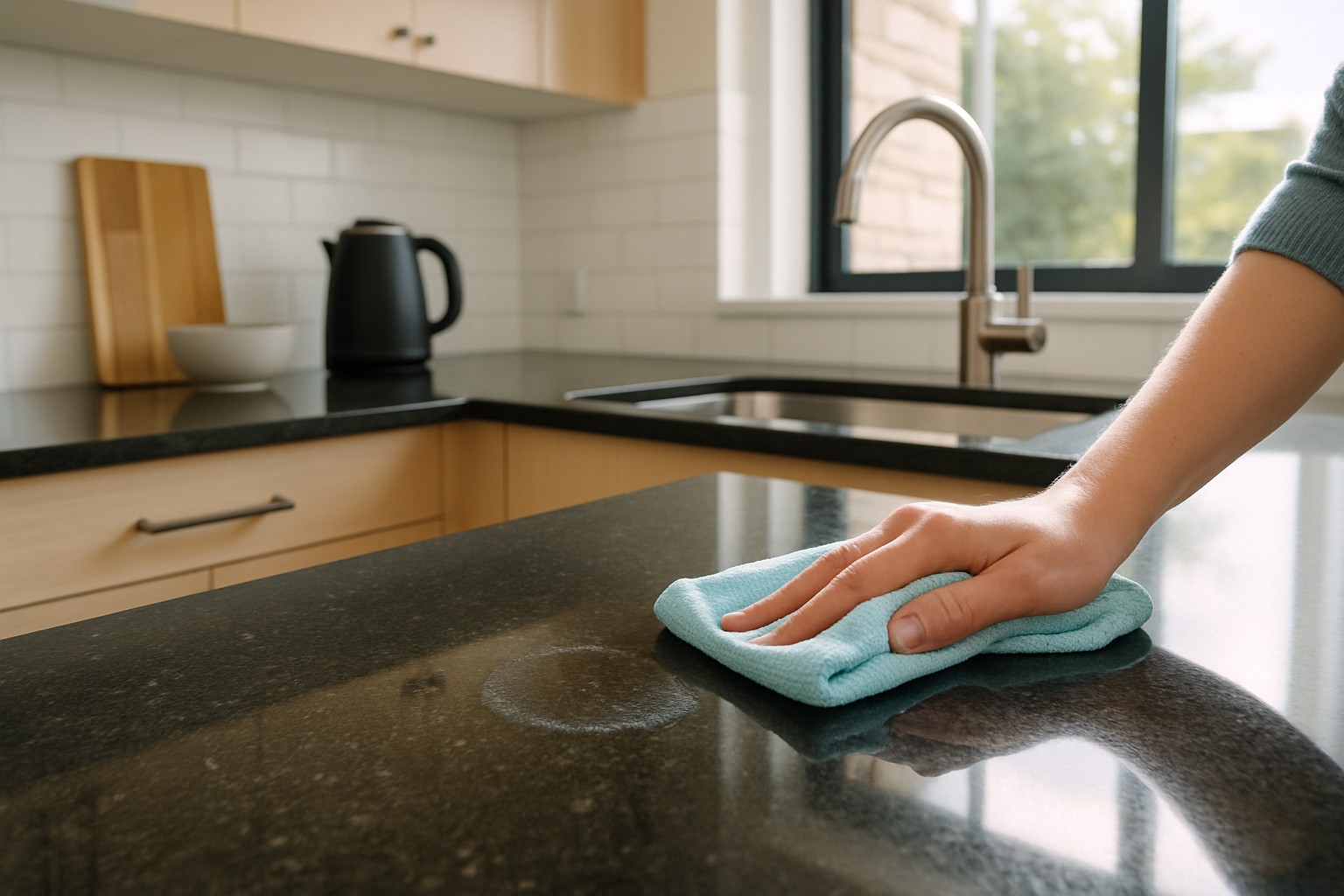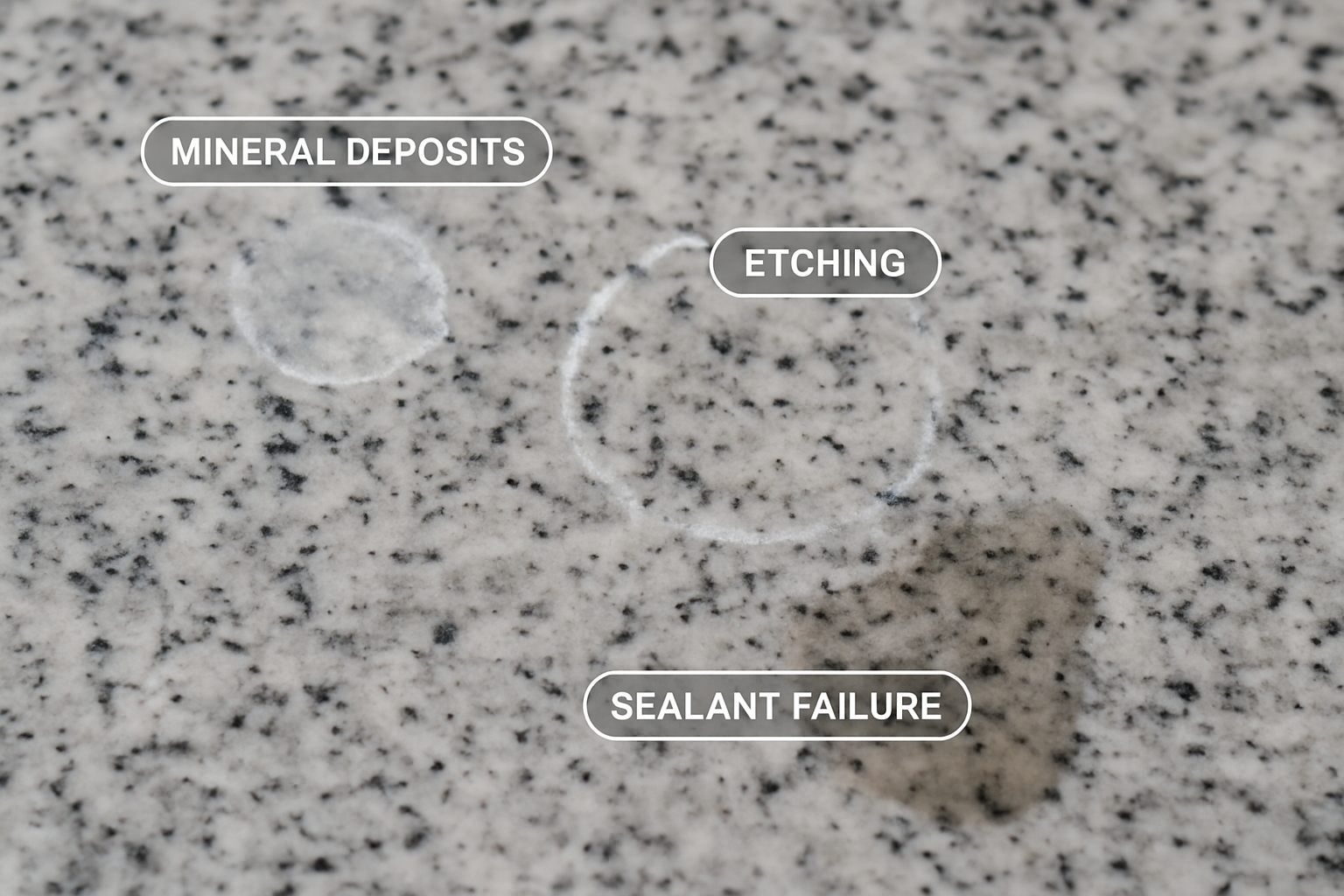Fix Water Marks on Granite Countertops Without Damage

Water marks on granite countertops can really get under a homeowner’s skin. They tend to dull the surface and steal a bit of the natural charm the stone proudly shows off.
Granite countertops bring style and strength to kitchens and bathrooms but water marks can sneak in and dull their natural beauty. This article guides you through a troubleshooting process to pinpoint what is causing these marks and offers safe, time-tested methods to banish them without harming the stone or its sealant. You’ll learn how to identify the type and severity of water marks, try gentle cleaning techniques, check for sealant issues, and get practical tips to keep your granite surfaces looking their best.
What You Really Need to Know About Those Pesky Water Marks on Granite Countertops
Water marks on granite often show up thanks to those pesky mineral deposits left behind when water evaporates, and sometimes you’ll find etching caused by acidic substances or even trouble with the surface sealant. It’s really important to know your water spots from the deeper stains and etching damage—each one needs a different approach to clean and protect your countertop without accidentally making things worse.
- Hard water minerals love to leave behind those pesky white or cloudy rings once the water dries up like unwanted little souvenirs.
- When moisture lingers too long, it can sneak into the sealants and let water creep into the granite, which is not a good look.
- Sealants that have seen better days or are past their prime won’t stand in the way of stains or water damage like they used to.
- Acidic culprits like lemon juice or vinegar can slowly nibble away at the surface and leave your finish looking dull.
- Using the wrong cleaners such as ammonia or bleach can backfire by breaking down the sealant or harming the stone and making stains worse instead of better.
Granite is naturally porous and just how much it soaks up really hinges on the quality and condition of the sealant protecting it. A good sealant acts like an invisible shield, creating a waterproof barrier that keeps moisture at bay and helps avoid those pesky discolorations and water marks.
Getting to Grips with the Type and Severity of Water Marks
Getting the diagnosis right is absolutely key when it comes to tackling water marks on granite effectively. By taking a close look at the visual signs and running a few straightforward tests you can usually suss out whether you’re dealing with a simple surface water spot, a stubborn deeper stain or even permanent etching damage.
- Take a good look at the color of the marks. White or cloudy spots usually point to mineral buildup, while darker or oddly discolored patches tend to be stubborn stains.
- Try gently wiping the mark with a damp microfiber cloth. If it lifts easily, chances are it’s just a surface water spot playing tricks on you.
- Drop a few drops of a mild granite-safe cleaner onto a small area and watch closely for any reaction or if the mark starts to fade. This quick test can save you some headache down the road.
- Pay attention to the size and exact spot of the discoloration. Covering a large area might mean it’s sunk deeper, or that your sealant is having an off day.
- Keep an eye out for etching signs like dull or rough patches where the granite looks chemically worn down. This is often the sneaky result of acids doing their thing.

Visual guide illustrating the different types of water marks on granite countertops to aid diagnosis.
Tried-and-True Ways to Banish Water Marks from Your Granite Countertops
Removing water marks from granite calls for cleaners that are gentle yet surprisingly effective—ones that can lift those stubborn mineral deposits without putting a scratch on the stone or its sealant.
- Gently wipe the affected area with a soft microfiber cloth dipped in warm water. This helps lift any loose deposits without causing a fuss.
- Grab a granite-safe, pH-neutral cleaner and follow the product’s instructions carefully. This is the best way to tackle mineral buildup without damaging the sealant.
- Whip up a mild paste from baking soda and water. Then softly rub it on those stubborn water marks in gentle circular motions with a soft cloth. Think of it as a little spa treatment for your countertop.
- If some stains just won’t quit, reach for a commercial granite stain remover that’s clearly labeled safe for natural stone. Be sure to stick to the manufacturer’s directions to avoid any mishaps.
- If the water marks have left your surface looking a bit dull, try a specialized stone polishing powder made for granite. This will revive that countertop shine without any scratching, of course.
It is best to steer clear of harsh chemicals and abrasive tools that might damage your granite. I’ve found that acidic cleaners like vinegar or lemon and scrubbing pads like steel wool are the usual culprits. Strong solvents such as bleach or ammonia can also cause damage. They slowly nibble away at the granite surface and wear down the sealant, turning water marks into stubborn stains or dull spots.
Fixing Sealant Problems Before They Turn into Water Marks Later (Because Prevention Is Way Better Than Scrubbing)
Water marks popping up more often than you would like usually signal that your granite’s sealant is starting to give up the ghost, letting water sneak into the stone and cause those pesky discolorations.
- Check your countertop’s seal by dropping a few drops of water on it and see if the water beads up like tiny marbles or soaks in within a few minutes. This test says a lot about your sealant’s job.
- The cleaner you start, the better the finish. Give the surface a good clean using a granite-safe cleaner to whisk away oils and dirt before you slap on fresh sealant.
- Choose a high-quality granite sealant that gels well with your countertop’s finish whether it’s shiny and glossy or smooth and matte. Matching the right sealant can make all the difference.
- Apply that sealant evenly with a soft cloth or applicator and keep a close eye on the instructions. A careful hand here pays off big time.
- Allow the sealant to dry and cure fully. Rushing this step is a rookie move. A patient wait ensures it bonds tightly and offers the best possible protection.
How often you need to reseal granite countertops can vary depending on the type of stone and how often it gets used. Usually resealing every one to three years does the trick, but areas that take a pounding or lighter-colored granites might need more frequent attention.
Tips for Preventive Care and Everyday Maintenance
Sometimes, the best way to avoid headaches down the road is to stay ahead of the game. With just a little effort day-to-day, you can keep things running smoothly and dodge bigger issues later on.
Consistent care and mindful habits go a long way in keeping those pesky water marks at bay and making sure your granite countertops stay looking sharp.
- Tackle spills right away, especially water to dodge mineral deposits before they get comfy.
- Avoid acidic or abrasive cleaners like the plague because they can mess with the sealant and stone underneath.
- Always have coasters, trivets and mats handy for glasses, pots and dishes. Your surfaces will thank you for keeping moisture and heat at bay.
- Stay on top of the sealant game by sticking to the recommended resealing schedule and giving it a regular once-over.
- Give your countertops a gentle once-a-week wipe down with pH-neutral granite cleaners or mild soapy water using soft cloths because your stone deserves a little TLC.
When It Really Pays Off to Call in a Pro for Granite Restoration
Water marks or damage can sometimes sneak past what you can fix yourself, especially if there’s deep etching or widespread sealant failure lurking beneath the surface. It’s really important to know when to call in the pros—otherwise, you might end up making things worse instead of better.
- Deep etching or stubborn dull spots that those trusty home remedies just can’t seem to fix no matter how hard you try.
- Large areas showing uneven discoloration or water stains that refuse to budge.
- Water marks that keep making an unwelcome comeback even after you’ve carefully cleaned and resealed—talk about persistence!
- Sealant that’s worn out or damaged beyond a simple touch-up and clearly waving a flag for professional refinishing.
Professional restoration services often rely on tried-and-true methods like honing to gently erase surface etching and polishing to revive lost shine, effectively removing stubborn water marks on granite countertops. Deep resealing then gives your granite an extra layer of tough protection.




